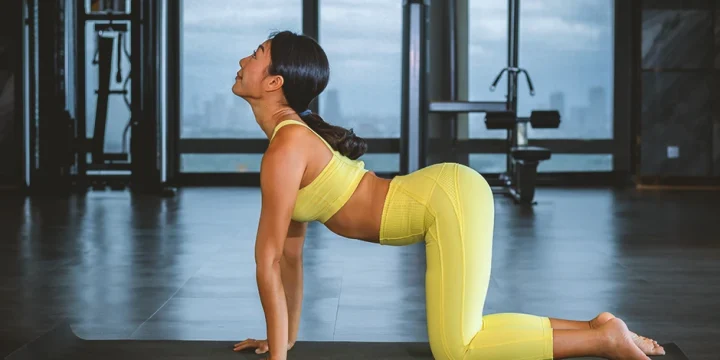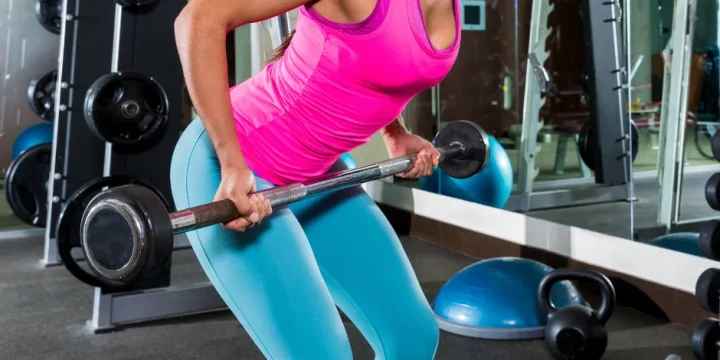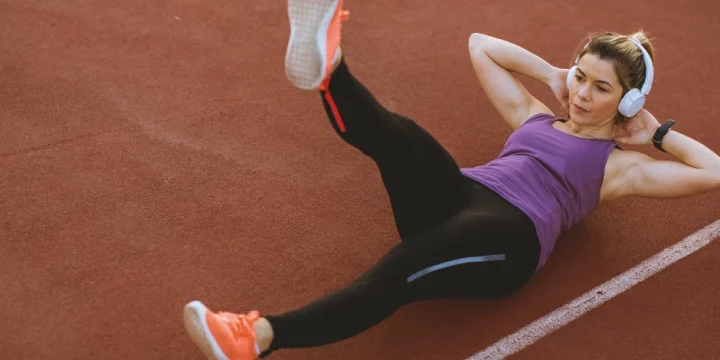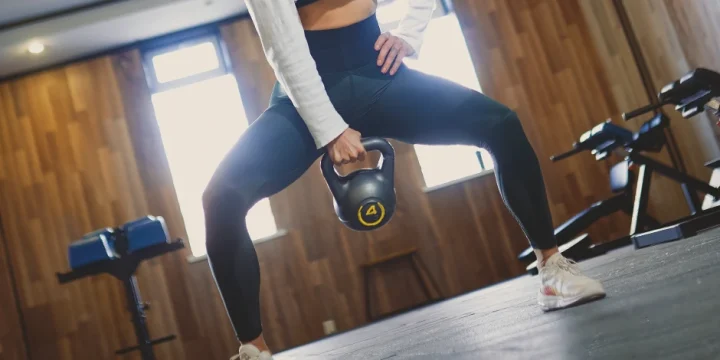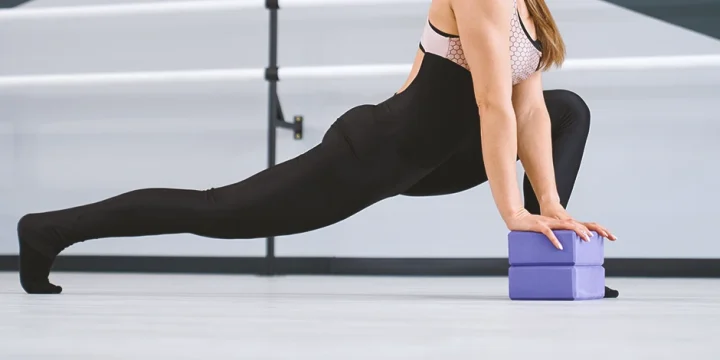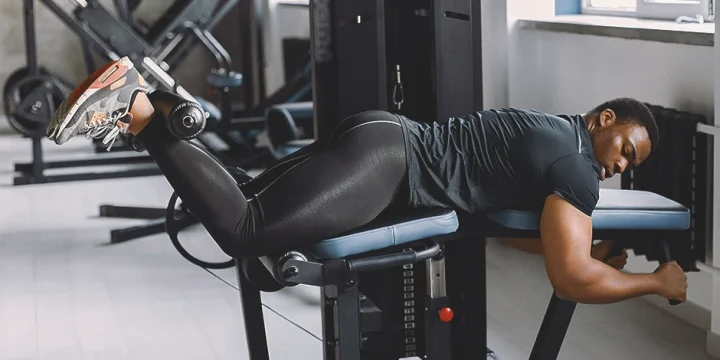Leg extensions are a go-to workout for directly emphasizing the quadriceps. It's a fantastic way to end a leg day.
However, your gym may not have a leg extension machine, or you may work out at home with limited gym equipment. Therefore you may perform other great leg extension substitutes to hammer your quadriceps.
As a fitness trainer, I've used several alternatives to leg extension to help my clients build stronger legs.
In this article, I will explain the alternative leg extension exercises and why you should substitute the leg extension machine.
Quick Summary
- Some leg extension alternative workouts include the Bulgarian split squat, reverse Nordic curl, step-ups, barbell hip thrust, reverse lunges, standing leg extension, and exercise ball squeeze.
- There are several variants to the leg extension workout, some of which give similar isolation-type quadriceps femoris muscle activation.
- According to a study in Frontiers, compound movements may improve your strength better than isolation exercises, which is why multi-joint quad exercises may be better than isolation movements.
- Based on the accessibility of your workout equipment, this multitude of alternate exercises can easily compensate for the hypertrophy caused by leg extensions in your training regimen.
The Best Leg Extension Alternatives

Based on my several years of training clients, here are the six best leg extension alternatives.
1. Bulgarian Split Squat
As a leg extension alternative, the Bulgarian split squats emphasize a deeper and longer range of motion, engaging the hamstrings, glutes, and quadriceps.
The Bulgarian split squat, a single-leg unilateral move, encourages your core to engage more intensively to balance and stabilize your body when bringing the weight back up on the upward motion of the lift into the heel.
"The Bulgarian split squat also works the glutes, which can aid in the development of a larger, more strong foundation in your legs and quads."
- Josh Henkin, Certified Strength & Conditioning Specialist
Here's how you do this exercise with good form:
- Begin by placing your feet hip-width apart with the left foot forward and the right foot behind the torso on a box or bench that is knee or slightly below knee height.
- Begin to drop into a lunging stance with your shoulders stacked precisely over your forward-facing hips. Hold a kettlebell or dumbbell vertically on each side of the body.
- Maintain a straight back while dropping your right knee to the ground.
- Go as low as possible, keeping your chest wide and your front knee from sticking out in front of your toes.
- When your right knee drops, drive your left foot into the ground, draw back on the left knee, and push the top of your right foot into the bench to return to the starting position.
- Repeat for reps.
2. Step-ups
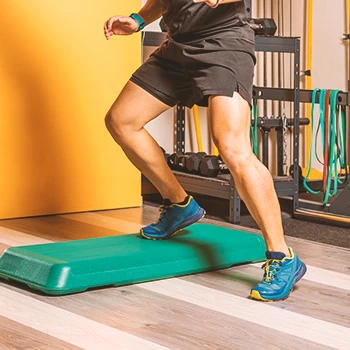
Step-ups may not appear to be much, but once you're comfortable, increase weights or reps to see — and feel — a gain in your lower body power.
Here's how you do this exercise with good form:
- Take a bench or a step that is at or near your knee level.
- Put your entire left foot on the bench or step.
- Step onto the step or bench with your right foot, meeting your left leg.
- Make sure you're pressing through the left (forward) heel in the upward action.
- Step down using the right foot, then the left leg, to return to where you started.
- Alternate leading feet between sets (for beginners), or finish one set of 8 to 12 rounds with the same leading foot, then switch.
Related: Best Step Exercises: Lower Body Routine
3. Squats
Squats are a bodyweight workout that works your quads. It is a leg extension alternative that works your butt, lower legs, core, and hips.
Here's how you do this exercise with good form:
- Stand, having your legs shoulder-width apart. Extend your toes gently. Clasp your hands or lay them by the sides. Lower your shoulders.
- Straighten your back and engage your core. Bend the knees and push your hips back.
- Reduce the angle of your hips until the front thighs are parallel to the ground. Keep your knees higher than your ankles.
- Stand up by pressing your heels into the ground.
- Repeat for reps.
Related: How To Do a Bodyweight Squat
4. Seated Banded Leg Extensions
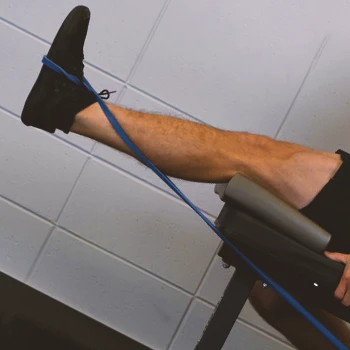
Concentrating on one foot at a time for the banded leg extension movement might help you maintain balance on the bench and finish repetitions with perfect form.
Here's how you do this exercise with good form:
- Sit on a chair or bench that allows your hips to form a 90-degree angle. Back support is recommended but not essential in this posture.
- Attach the band behind you and wrap it around one of your shins or your ankle (for greater resistance, fold the resistance band up and loop it through the lower leg; the more stress on the band from the bottom setup, the more resistance you will experience - ideally, you want the resistance band to be quite tight from the start position).
- Begin with your hips and knees flexed and oppose the band as you drive into leg extension.
- Maintain an erect posture throughout the workout.
- Rep on the other leg.
Related: Best Resistance Band Stretching and Mobility Exercises
5. Reverse Lunge
Reverse lunge is a good leg extension alternative that builds and tones your quads.
They also engage the hamstrings, glutes, and core, giving you a more dynamic exercise.
Here's how you do this exercise with good form:
- Place your feet shoulder-width apart.
- Step back with your right foot. Reduce the angle of your right knee to a 90-degree.
- Push onto your right foot to return to the starting position.
- Repeat for reps, and change to the left leg.
6. Cyclist Squat
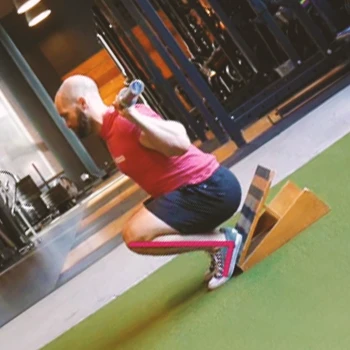
Another leg extension alternative is the cyclist squat, often called the quad squat.
Fair warning: the elevation makes this exercise heavily quad-focused, so I'd do them before other compound quad exercises.
Here's how you do this exercise with good form:
- Stand with the feet shoulder-width apart.
- Place the heels on the plate or the curb. Keep both hands clasped together or straight ahead.
- Tighten your core.
- Bend your knees and squat until your hamstrings contact your calves.
- Push up to return to your starting position.
- Repeat for the desired number of reps.
"Your feet are close together, and the heels are elevated. This allows your hips to slide straight down, forcing your quads to exercise harder."
- Mike Schultz, Certified Personal Trainer
What Are Leg Extensions?
The leg extension exercise is an isolation workout that targets the quadriceps muscle.
It is classified as a resistance weight training exercise.
The seated leg extension is typically performed by raising a padded lever with the lower legs on a good leg extension machine.
Muscle Groups Targeted by Leg Extension

The leg extension action targets the quadriceps muscle – the muscle groups at the front of the thigh.
The quadriceps are responsible for initiating knee extension and flexion [1].
This motion isolates the quadriceps muscle groups placed in the front of the upper leg.
The quadriceps femoris muscle group comprises four separate muscles in the front part of the thigh: the rectus femoris, vastus medialis, vastus lateralis, and vastus intermedius.
- Vastus lateralis: The biggest of the four quadriceps muscle groups. The vastus lateralis connects the thigh bone (femur) to the knee cap (patella) and moves down the exterior of the thigh [2].
- Vastus medialis: Also known as the "teardrop quad" muscle, this muscle is readily apparent. It connects the femur to the patella and travels along the interior of the thigh [3].
- Vastus intermedius: The innermost of the four muscle groups, it runs between the vastus lateralis and vastus medialis muscles, thus the name intermedius [4].
- Rectus femoris: The only quadriceps muscle group that traverses at both the knee and hip joints. It goes down the leg straight, flexing the thigh at the hip joint and extending at the knee [5].
Are Leg Extensions Bad?

The leg extension is not bad. However, they can be if not performed with proper form.
Incorrect application of a leg extension could appear as follows:
- Using too much weight
- Extremely high rep-range
- Incorrect posture
- Hip misalignment
- Using the incorrect technique
Aside from technique and inappropriate machine use, traditional leg extensions are an "open-chain" workout.
Because your feet are not fixed on the ground, this exercise allows them to move freely.
While this helps isolate a certain muscle, it may increase the likelihood of knee injuries.
Furthermore, leg extensions cannot be translated into real-life muscle functioning, implying that the motion is not repeated in normal human activity.
Why You Should Substitute the Leg Extension Machine

Here are some reasons you should substitute the leg extension machine.
1. Enhanced Range of Motion
The primary benefit of performing exercises other than leg extensions is the increased range of motion.
The leg extension has a restricted motion range, which is important in promoting muscular hypertrophy, development, and improved strength characteristics.
Bulgarian split squats, hack squats, walking lunges, and landmine squats emphasize increased muscle coverage, boosting time under strain, and lower body power.
2. Increased Strength
Even though leg extensions will build quad and leg strength, a longer time under stress and range of motion will allow for more power.
To compensate for the limited motion range and increase duration under strain, you can increase overall exercise volume with the leg extension; however, this will necessitate more sets and repetitions.
3. Improved Functionality
The leg extension is a vanity exercise. Because the leg extension action is not seen in common human movement patterns, it is not classified as functional.
The leg extension is a solitary action traditionally utilized by bodybuilders and aestheticians.
This article's leg extension alternate workouts can help you improve your functional movement, mobility, power, and core stability.
4. Compound Exercises Are Better
While isolation exercises have their place, I'm a huge proponent of compound exercises — exercises that work more than one muscle group at once.
Our list features compound movements that not only work your quads but leg muscles as well, improving overall strength and mobility and teaching your muscles to work together.
According to a study in Frontiers, compound movements may improve your strength better than isolation exercises [6].
Related posts:
FAQs
How Do You Prevent Knee Pain When Doing Leg Extensions?
You prevent knee pain when doing leg extensions by restricting the motion of these exercises. You can start in a seated posture and only extend your legs halfway.
Should I Skip Leg Extension?
No. You shouldn't skip leg extension. They may be a valuable addition to your exercises if you have healthy knees and a well-balanced regimen if you want to gain maximal quadriceps growth.
Can I Do Squats Instead of Leg Extensions?
You should do both squats and leg extensions. Squats do not engage the rectus femoris. They will train your vastus lateralis (the sweep) in the center and towards the knee, but not up to your hip. Leg extensions are ideal for rectus femoris development and vastus lateralis expansion towards the hip.
References:
- https://www.ncbi.nlm.nih.gov/pmc/articles/PMC9598811/
- https://pubmed.ncbi.nlm.nih.gov/30335342/
- https://www.sciencedirect.com/topics/veterinary-science-and-veterinary-medicine/vastus-medialis
- https://www.ncbi.nlm.nih.gov/pmc/articles/PMC8482252/
- https://www.ncbi.nlm.nih.gov/books/NBK539897/
- https://www.frontiersin.org/journals/physiology/articles/10.3389/fphys.2017.01105/full
About The Author
You May Also Like
